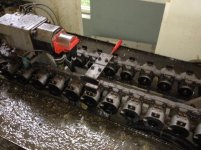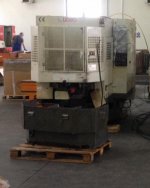I'm thinking about getting a 2001, out of service, Roku Roku Libero RX6 HMC. At this moment it is due for scrapping, pricing should be near scrap metal, and I contemplate about saving it.
I do have a 9-5 in the machining business, but this will be a hobby gig. Not sure were I will end up with it. If I won't fail the retrofit, I'll keep it as a white machine for black days. Who knows.
I do have my fare share of diy, and I do like wrenching so, it can't hurt a bit of play.
Main concern is my lack of knowledge via electrical/electronics part.
Either way, I do know what am I getting into.
Short machine description:
- very small footprint
- double pallet
- Nikken CNC-201 unit as the fourth axis
- 2.2KW 12 or 15000 rpm
- ISO 30 spindle
- 30 tools chain + shifter, index ATC
- Fanuc 18
- Small Fanuc aplha series servos (red caps)
- 40.000mm/min rapids
- roughly only 6 years in use
- though it was kept indoors, it wasn't prepaired for preservation. Few rusty dots on the guides, spindle was blocked etc
- all the amps, controls etc are missing. Though, I could recoup them from her sisters
For starters, I would wan't to avoid keeping her with Fanuc controller. I do like Fanuc, but for hobby use, I can't afford their service costs. A middle way it's impossible since it is way too proprietary.
My first priority is to make sure there is a solution for what I'm trying to do. At this point barriers that block my view are as follows:
- Peripheral stuff: pumps, brakes, pallet changer, doors, sensors, ATC, pneumatic valves etc. Should I govern them via macros in Mach4, go via a PLC or go the old school way of relays?
- I have Fanuc servos for the tool magazine and for the pallet changer. Do I need drives for these motors? or they can be driven directly via a PLC?
- Fanuc red caps - should I use a converter for the encoders? or just change the encoder?
- Controller would be CSMIO analog version. If I definitely need drives for the pallet changer/atc magazine servos, I'm thinking to replace these with steppers. This case would require the step/dir version of CSMIO
- HMI - heard the term Pokeys as a solution, or some other gadget from CS Labs that can do the trick. I'm looking for stable, 100% reliable analog controls. Example feed override.
- is Mach4 stable enough to keep things safe? 40m rapids can get dangerous
- anybody have experience with Nikken 4th axes? drives, motors etc
- not sure what holds the tight precision on these machines. Quality ball screws? or is there some serious mapping in the old controller?
Any advice is more than welcome,
Thanks,
M.
I do have a 9-5 in the machining business, but this will be a hobby gig. Not sure were I will end up with it. If I won't fail the retrofit, I'll keep it as a white machine for black days. Who knows.
I do have my fare share of diy, and I do like wrenching so, it can't hurt a bit of play.
Main concern is my lack of knowledge via electrical/electronics part.
Either way, I do know what am I getting into.
Short machine description:
- very small footprint
- double pallet
- Nikken CNC-201 unit as the fourth axis
- 2.2KW 12 or 15000 rpm
- ISO 30 spindle
- 30 tools chain + shifter, index ATC
- Fanuc 18
- Small Fanuc aplha series servos (red caps)
- 40.000mm/min rapids
- roughly only 6 years in use
- though it was kept indoors, it wasn't prepaired for preservation. Few rusty dots on the guides, spindle was blocked etc
- all the amps, controls etc are missing. Though, I could recoup them from her sisters
For starters, I would wan't to avoid keeping her with Fanuc controller. I do like Fanuc, but for hobby use, I can't afford their service costs. A middle way it's impossible since it is way too proprietary.
My first priority is to make sure there is a solution for what I'm trying to do. At this point barriers that block my view are as follows:
- Peripheral stuff: pumps, brakes, pallet changer, doors, sensors, ATC, pneumatic valves etc. Should I govern them via macros in Mach4, go via a PLC or go the old school way of relays?
- I have Fanuc servos for the tool magazine and for the pallet changer. Do I need drives for these motors? or they can be driven directly via a PLC?
- Fanuc red caps - should I use a converter for the encoders? or just change the encoder?
- Controller would be CSMIO analog version. If I definitely need drives for the pallet changer/atc magazine servos, I'm thinking to replace these with steppers. This case would require the step/dir version of CSMIO
- HMI - heard the term Pokeys as a solution, or some other gadget from CS Labs that can do the trick. I'm looking for stable, 100% reliable analog controls. Example feed override.
- is Mach4 stable enough to keep things safe? 40m rapids can get dangerous
- anybody have experience with Nikken 4th axes? drives, motors etc
- not sure what holds the tight precision on these machines. Quality ball screws? or is there some serious mapping in the old controller?
Any advice is more than welcome,
Thanks,
M.





